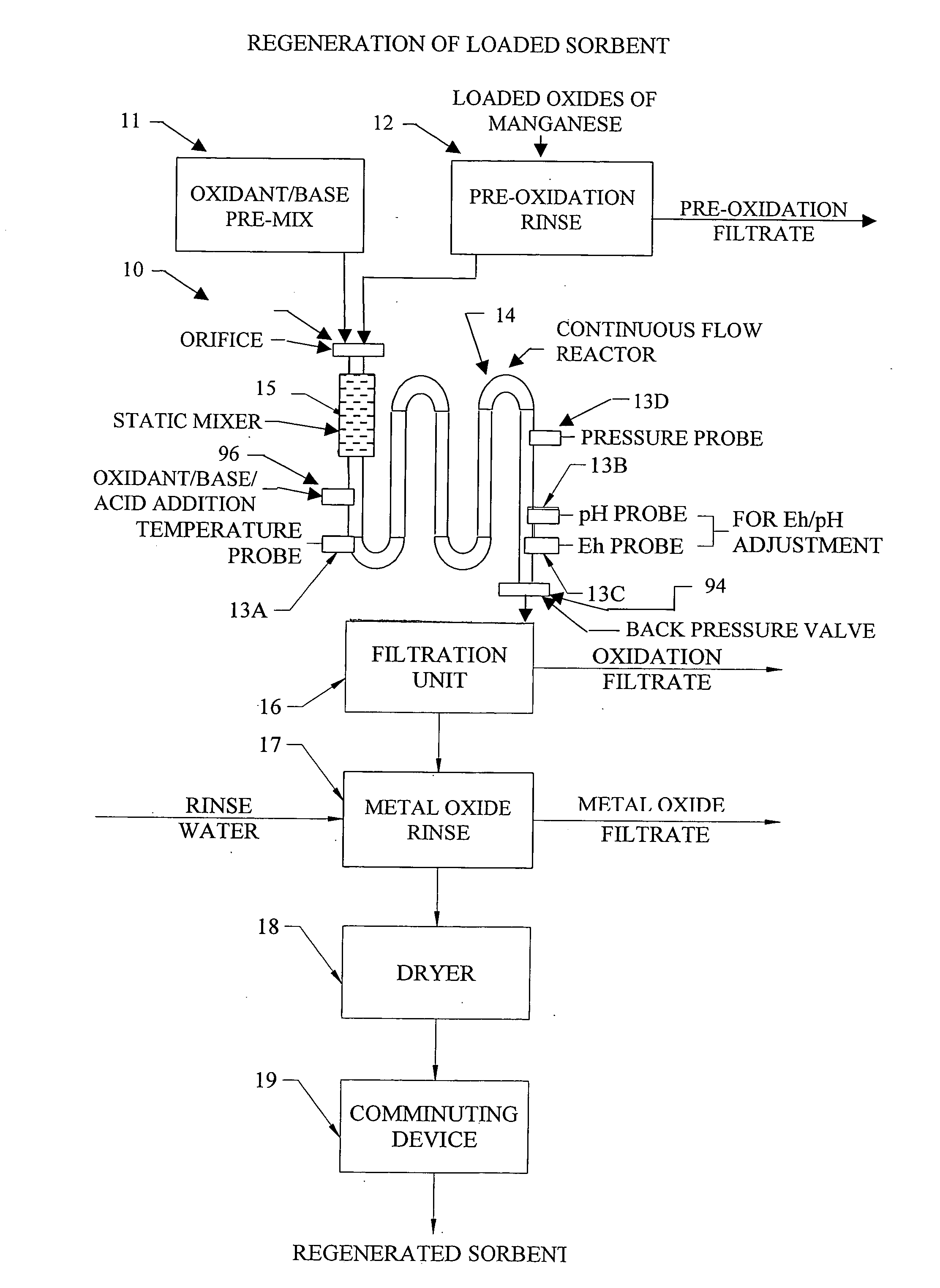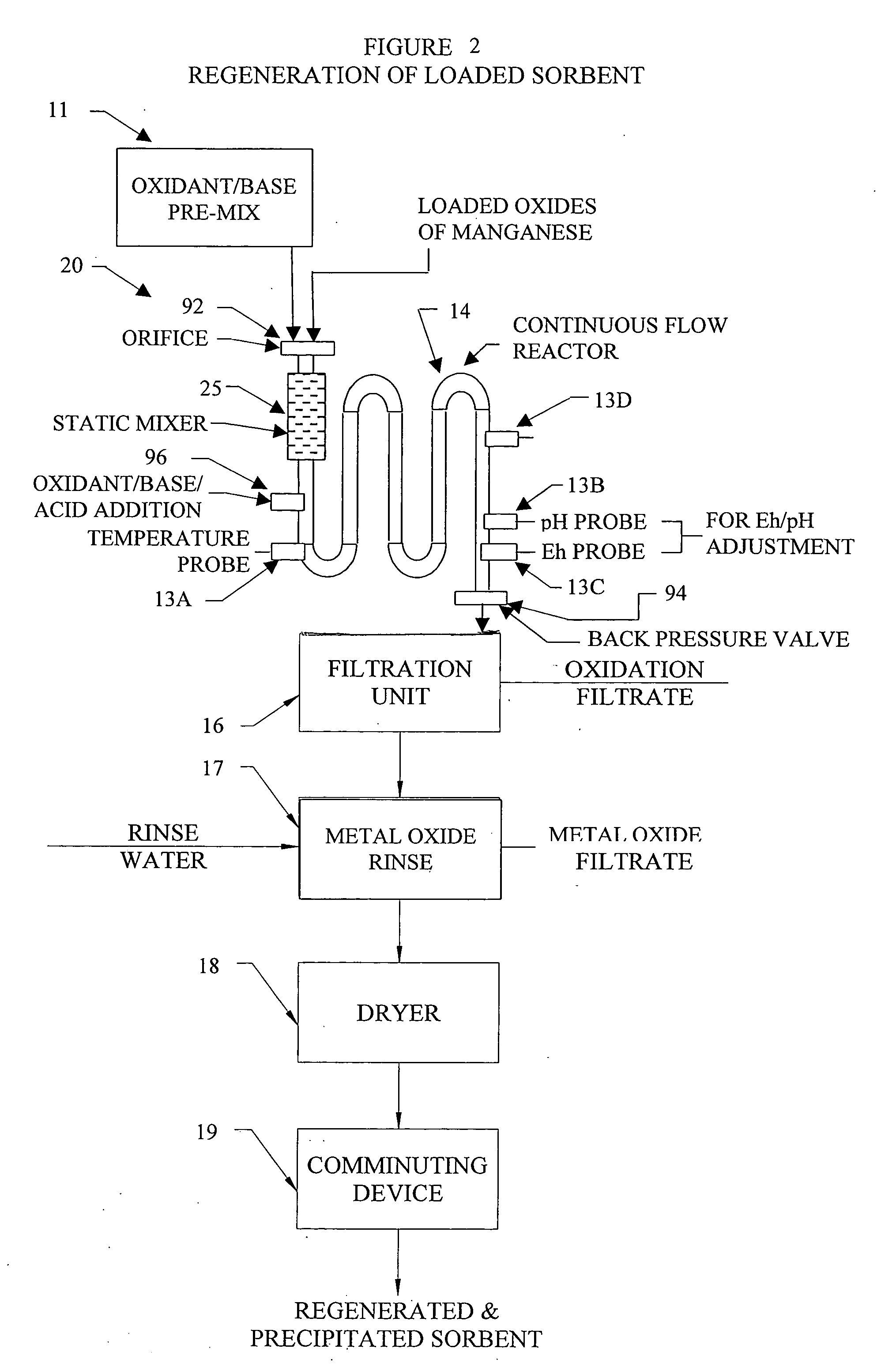Metal oxide processing methods and systems
a technology of metal oxide and processing methods, applied in the direction of lithium compounds, chromium oxide/hydrates, fluid pressure control, etc., can solve the problems of uneconomical industrial applications of this attribute, overly costly pollutant removal systems, sorbent regeneration systems, waste removal systems, etc., and achieve disappointing pollutant removal performance and marginal economic return
- Summary
- Abstract
- Description
- Claims
- Application Information
AI Technical Summary
Benefits of technology
Problems solved by technology
Method used
Image
Examples
example 1
[0256] As an illustrative example not intended to be limiting in scope, metal oxide based sorbents created with foreign cation addition techniques and metal precipitation onto substrates as detailed in the Applicant's invention using either the continuous flow reactor or batch processes are detailed in the following example. A series of metal oxide based sorbents were created and analyzed for specific particle characteristics. Table 2, provides a summary of the prepared metal oxide sorbents along with a summary of key particle characteristic data.
[0257] Eleven metal oxide sorbents were all produced in accordance to the methods of the Applicant's invention and utilized potassium persulfate (K2S2O8) as the oxidant in the oxidizing aqueous solution and potassium hydroxide (KOH) and for pH control and are all labeled A-K in Table 2. Seven of the sorbents, labeled A-G, were prepared utilizing the Applicant's inventive concept of adding metal cations of primary and secondary metals to a ...
example2
[0259] As an illustrative example, metal oxide based sorbents created with foreign cation addition techniques and metal precipitation onto substrates as detailed in the Applicant's invention using either the continuous flow reactor or batch processes are detailed in this Example 2. In Example 2, a series of metal oxide based sorbents were created and tested for removal of various target pollutants. Table 3, provides a summary of the prepared metal oxide sorbents and target pollutant removal data.
[0260] The metal oxide sorbents 1-6 were all precipitated in accordance to the methods of the Applicant's invention and utilized potassium persulfate (K2S2O8) and potassium hydroxide (KOH) and the oxidizing aqueous solution. Sorbent 1 was prepared utilizing the Applicant's inventive concept of adding a primary and secondary metal cation to a newly precipitated metal oxide, in the case Fe2O3. For Sorbent 1, a metal oxide soluble salt solution of 0.5 Mole Fe2(SO4)3 and {fraction (1 / 32)} mole ...
examples 3-5
[0265] As discussed, the ability of metal oxide based sorbents to remove target pollutants can be controlled through various embodiments of the Applicant's invention. One such embodiment is by introducing foreign metal cations into the primary metal oxides crystalline structure. These foreign metal cations can be introduced in multiple ways during the processes as detailed previously in the multiple embodiments of the invention, both in a batch or continuous flow reactor process. One such method for the introduction involves the metal cations associated with the specific oxidants and bases used to prepare the oxidizing aqueous solution and base for pH control. By way of non-limiting example, potassium (K2S2O8) and sodium (Na2S2O8) persulfates and potassium (KOH) and sodium (NaOH) hydroxides can supply a K+2 or Na+2 to the primary metal oxide. Foreign cation introduction can alternatively be accomplished by using a soluble metal salt solution, such as K2SO4 or NaSO4, as utilized when...
PUM
| Property | Measurement | Unit |
|---|---|---|
| temperature | aaaaa | aaaaa |
| particle size | aaaaa | aaaaa |
| temperatures | aaaaa | aaaaa |
Abstract
Description
Claims
Application Information
 Login to View More
Login to View More - R&D
- Intellectual Property
- Life Sciences
- Materials
- Tech Scout
- Unparalleled Data Quality
- Higher Quality Content
- 60% Fewer Hallucinations
Browse by: Latest US Patents, China's latest patents, Technical Efficacy Thesaurus, Application Domain, Technology Topic, Popular Technical Reports.
© 2025 PatSnap. All rights reserved.Legal|Privacy policy|Modern Slavery Act Transparency Statement|Sitemap|About US| Contact US: help@patsnap.com



